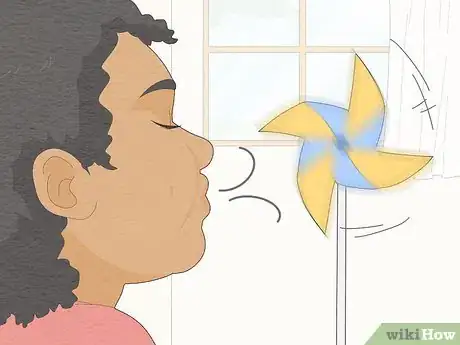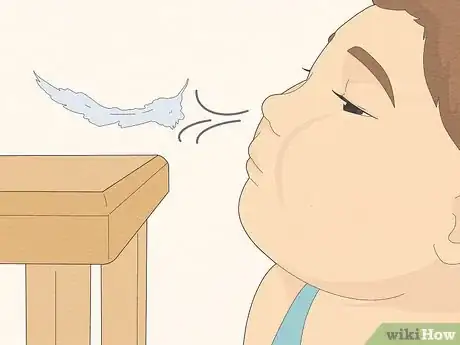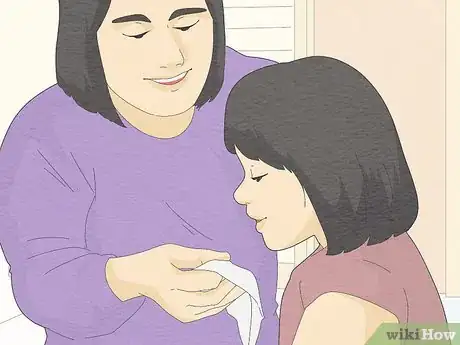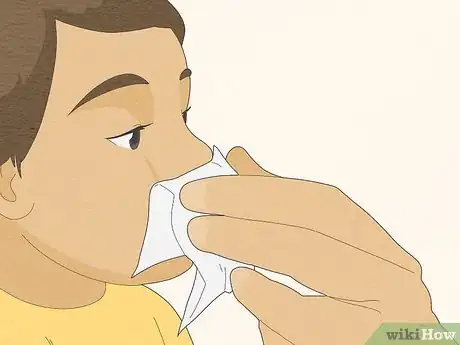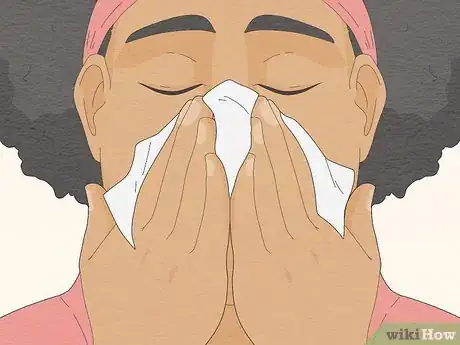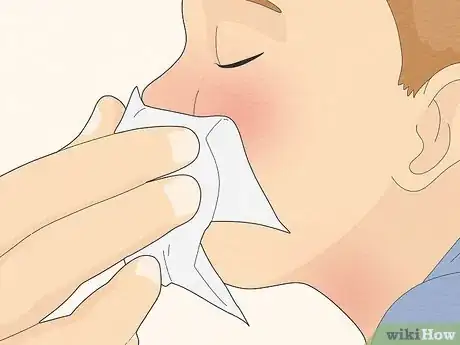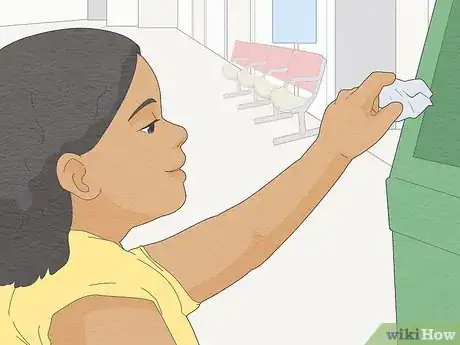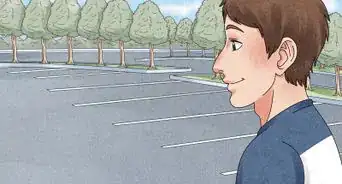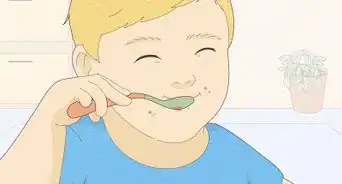This article was co-authored by Catherine Palomino, MS. Catherine Palomino is a former Childcare Center Director in New York. She received her MS in Elementary Education from CUNY Brooklyn College in 2010.
This article has been viewed 207,666 times.
Teaching your child to blow their nose is a lesson in hygiene and etiquette. Children as young as two years old can start to learn this skill by imitating their parents and older siblings. The easiest way to teach your child to blow their nose is to teach it in its two component parts, with lots of praise. Making the new skill fun, rather than a chore, will help both parent and child to stick with it.
Steps
Learning to Intentionally Blow Air
-
1Teach your child the concept of blowing air intentionally. Blowing air, whether through the mouth or the nose, is a learned skill. Unlike breathing regularly, blowing involves intention. If your child likes to imitate your actions, start by encouraging imitation when they are well. You should do the action first, and your child can imitate what you do.[1]
- Practice first by blowing with the mouth. Blowing bubbles, using a soapy bubble mixture and a plastic bubble wand, is a very satisfying way to learn to control breath by blowing.
- The tradition of blowing out birthday candles offers another perfect opportunity to practice this skill in a fun way. You can pretend to blow out the candle, while allowing your child to actually blow it out.[2]
- You can also hold a piece of tissue paper about six inches from your child's face, and show them how to make the tissue move by blowing on it. Other things your child can blow with their mouth include pinwheels, straws, and balloons, all of which help reinforce that air should come through their lips.
-
2Teach your child how to blow air out of their nose. Have them put their hand below your nostrils so they can feel the air as you blow. Show them how you can cover one nostril, then the other, to blow through each nostril individually.
- When you're first teaching your child to blow through their nose, remind them to keep their mouth closed. It can help to cover one nostril, then the other, to reinforce the feeling of air blowing through the nose. This will be easier to do when he's well, both because they will likely feel better and be more interested in learning new things, and because they will have more of a sense of air moving through the nostrils.
- Make a game out of blowing air through the nose. Children often are motivated by races. You can create a "race" for two extremely lightweight objects (a sequin or a feather works well) and see who can blow it from one end of a table to the other the quickest.[3]
Advertisement -
3Explain what is happening with blowing. Have fun taking air inside the body quickly, and blowing air outside the body quickly. This is a process of teaching your child to control the air that goes through their nose.
- Explain the purpose of blowing the nose. Show your child what mucus is. Use pictures, or hold a mirror up to your child's nose so that they can see what's inside.[4]
- By teaching your child to connect excess mucus to colds, allergies, etc., you'll increase their understanding of why blowing their nose is important. This will help them make sense of why you might ask them to "blow their nose" when they needs to.
Teaching Your Child To Use a Tissue
-
1Practice holding a tissue to your child's nose. Provide plenty of praise for trying this new thing, even when they're not sick. Try getting a fun box of tissues with interesting patterns or designs on it to encourage your child to use them more often.
- Try different varieties of tissue paper, and have your child tell you which one they prefer. Some children may be extremely sensitive to texture or scents that you may not even notice. Having a tissue paper that the child doesn't mind will help this teaching process tremendously.
- Make sure you have plenty of the kind of tissue paper your child prefers ready when they're sick. When your child is sick, it's likely that he'll resist doing anything new. They will likely want to be left alone, or cuddled, so be gentle.
-
2Point out when yourself or other adults use a tissue to blow their noses. When you have a cold, you can use this opportunity to model using a tissue to blow your own nose, encouraging your child to imitate.[5]
- Siblings can also serve as role models for your child as they learns how to blow their nose. Younger siblings might be distinguished by the fact that they aren't old enough to blow their own nose. Often, this comparison has a good deal of attraction for an older sibling.
- Explicitly point out the steps of blowing the nose, as you do them or as others do. Narrate the process as you go through the steps.
-
3Help your child blow their nose when they're sick by holding the tissue to their nose and telling them to blow. They might need to be reminded to close their mouth.
- Keep a gentle, light tone of voice when teaching this new skill.
- If your child wants to hold the tissue themselves, let them! While it may be easier for the child to learn simply by blowing into a tissue you hold, some children may prefer to be in charge of their own tissue.
- Consider using a humidifier or saline spray to help loosen the mucus if your child is struggling to blow their nose while sick.
-
4Teach your child to throw away the tissue immediately after they finish blowing. This may mean that you go through more tissues than you'd like, but teaching the routine of throwing the tissue away will benefit you, and your child, in the long run.
- Sometimes the routine of throwing the tissue into the trash can will be a fun incentive for the child in itself. Provide plenty of praise for each tissue that goes from tissue box, to nose, to trash.
- Always have a trash bin close by as you are teaching this process. If you don't actually have a trash bin so close at hand, improvise by finding another receptacle (such as a plastic container, or an empty bowl) that can function as a temporary trash location until you can move it.
Community Q&A
-
QuestionI have a little girl in my class who is 9 years old. She has been diagnosed with Angelman Syndrome. She cannot blow her nose at all. I have tried every excercise with her. Any advice?
 Community AnswerYou should tell her to hold a paper towel to her nose and blow pressure out of her nose until something comes out. Or you should teach her how to clean her nose with a cotton bud when she is at home. She can use nasal spray until fluids come out, then she can blow medium pressure onto a towel to blow her nose.
Community AnswerYou should tell her to hold a paper towel to her nose and blow pressure out of her nose until something comes out. Or you should teach her how to clean her nose with a cotton bud when she is at home. She can use nasal spray until fluids come out, then she can blow medium pressure onto a towel to blow her nose. -
QuestionDoes blowing one's nose with enlarged adenoids cause pain or discomfort to the sinuses? My son is literally afraid to blow.
 Trolling_and_lollingCommunity AnswerYes, that can cause discomfort, and if your child is younger, it'll be worsened. Ask your son to do it himself by insisting he must, or take a nasal spray to clear the airways. Consider taking him to a doctor.
Trolling_and_lollingCommunity AnswerYes, that can cause discomfort, and if your child is younger, it'll be worsened. Ask your son to do it himself by insisting he must, or take a nasal spray to clear the airways. Consider taking him to a doctor.
Warnings
- Some children ages 2-10 are susceptible to nosebleeds. Your child should not attempt to blow their nose if experiencing a nosebleed. For more information on treating nosebleeds, see Stop a Nose Bleed⧼thumbs_response⧽
References
- ↑ http://www.natlallergy.com/images/art/blownose.pdf
- ↑ http://www.natlallergy.com/images/art/blownose.pdf
- ↑ http://www.parenting.com/toddler/health/how-to-teach-kids-to-blow-their-nose
- ↑ http://www.parenting.com/toddler/health/how-to-teach-kids-to-blow-their-nose
- ↑ http://www.whattoexpect.com/toddler/grooming/toddler-nose-care.aspx
About This Article
To teach your child to blow their nose, first encourage them to blow air through their mouth as this will teach them the concept of intentional air blowing. You can do this by showing them how to blow bubbles and practicing blowing out candles. When you're ready to progress to nose blowing, encourage them to keep their mouth closed and race to see who can blow a feather from one end of a table to the other the fastest using only their nose. Finally, explain why they should blow their nose and show them what mucus is so they can connect this to colds and allergies. For more tips from our co-author, including teaching your child to use a tissue, read on!
